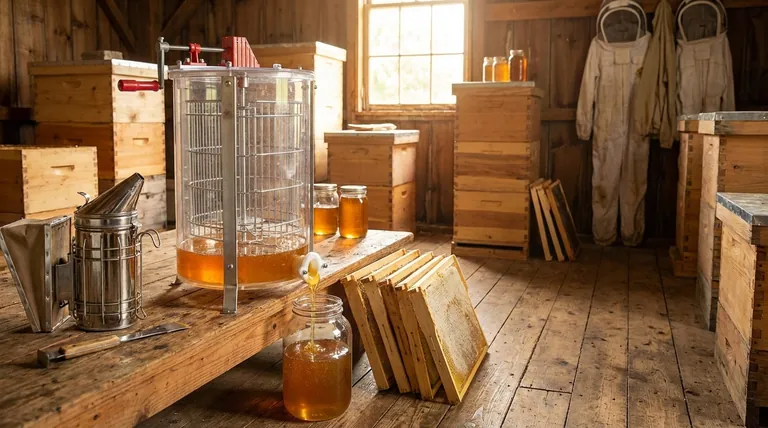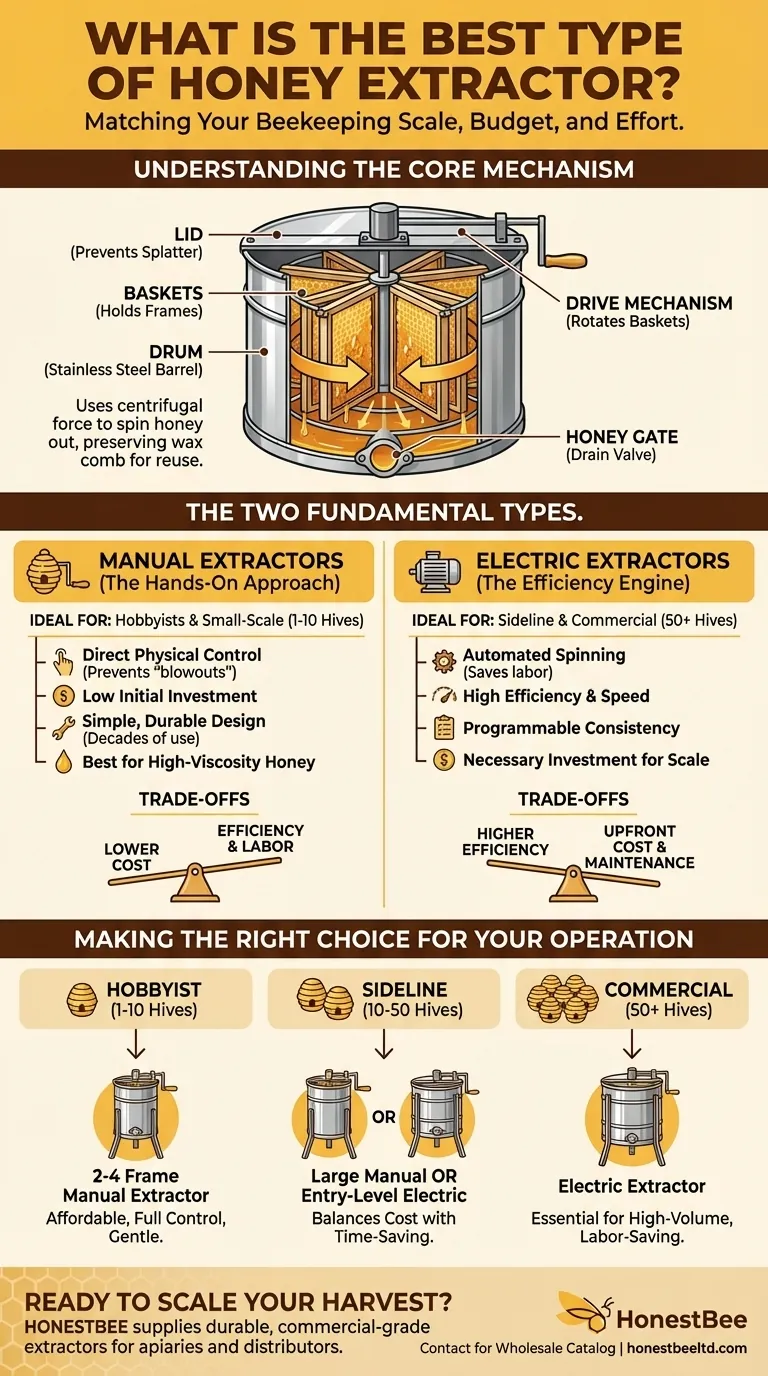Ultimately, the "best" honey extractor is the one that correctly matches your beekeeping scale, budget, and physical-effort tolerance. For small-scale hobbyists, a manual two-frame extractor is often the ideal choice, while commercial operations require the efficiency of a large, electric model. The decision is a direct trade-off between upfront cost and long-term labor savings.
Your choice of a honey extractor comes down to a fundamental question of resources. Manual extractors prioritize a low initial investment and user control, making them ideal for hobbyists. Electric extractors prioritize time and labor efficiency, a necessary investment for any serious or commercial-scale operation.

Understanding the Core Mechanism
Before comparing models, it's essential to understand what an extractor does and how it works. This knowledge clarifies why certain features matter more than others.
What Is a Honey Extractor?
A honey extractor is a mechanical device that uses centrifugal force to spin honey out of uncapped honeycomb frames.
This process is highly efficient and, crucially, preserves the wax comb. The beekeeper can then return the empty frames to the hive, saving the bees thousands of hours of energy they would have spent rebuilding the comb from scratch.
Key Components of Any Extractor
Regardless of type, all extractors share a common anatomy designed to perform this task.
- Drum: The large barrel, typically stainless steel, that contains the spinning operation.
- Baskets: The internal rack that holds the honeycomb frames in place.
- Lid: A cover to prevent honey from splattering out during extraction.
- Drive Mechanism: Either a manual hand crank or an electric motor that rotates the baskets.
- Honey Gate: A spigot or valve at the bottom of the drum used to drain the collected honey.
The Two Fundamental Types of Extractors
The most significant decision you will make is choosing between a manual and an electric model. This choice directly impacts your cost, efficiency, and the overall experience of honey harvesting.
Manual Extractors: The Hands-On Approach
Manual extractors are powered by a hand crank, giving you direct, physical control over the extraction speed. They are the standard for hobbyists and small-scale beekeepers.
This fine-tuned control is excellent for preventing "blowouts," where rapid spinning can destroy delicate new comb. Many beekeepers also value the tactile, hands-on connection to the harvest process. A simple two-frame manual extractor is sufficient to process dozens of buckets of honey and is particularly good for thick, high-viscosity harvests.
Electric Extractors: The Efficiency Engine
Electric extractors use a motor to spin the frames, automating the most labor-intensive part of the job. These are essential for any beekeeper who values time and efficiency over initial cost.
These models are designed for sideline or commercial operations, generally defined as managing 50 to 200+ colonies. Features like adjustable speed control allow for a gentle start before ramping up, maximizing honey removal while minimizing comb damage and saving immense amounts of physical labor.
Understanding the Trade-offs
Choosing an extractor is an exercise in balancing competing priorities. Being aware of the trade-offs is key to making a decision you won't regret.
Cost vs. Efficiency
A manual extractor has a significantly lower upfront cost, making it an accessible entry point. An electric model is a major investment but pays for itself in saved time and labor, allowing you to process more honey in a fraction of the time.
Control vs. Automation
Manual cranking offers unparalleled, moment-to-moment control over speed and direction. This is ideal for carefully handling fragile combs. Electric models offer programmable, repeatable consistency that is impossible to achieve by hand, ensuring an efficient workflow for hundreds of frames.
Lifespan and Maintenance
Due to their simple mechanical design, manual extractors have very few failure points and can last for decades with minimal care. Electric models involve motors and electronics that require more maintenance and have more potential points of failure, though a well-cared-for machine will still provide many years of service.
Making the Right Choice for Your Operation
Filter your decision through your primary goal. The "best" extractor is simply the right tool for your specific job.
- If your primary focus is hobby beekeeping (1-10 hives): A two- or four-frame manual stainless steel extractor offers the perfect balance of affordability, control, and durability.
- If your primary focus is growing a sideline business (10-50 hives): Consider a larger manual extractor or a small, entry-level electric model to begin saving significant time during harvest.
- If your primary focus is commercial production (50+ hives): An electric extractor is a non-negotiable investment in operational efficiency that will define your ability to scale.
By clearly identifying your operational scale and goals, you can confidently select the extractor that will serve as a valuable asset for years to come.
Summary Table:
| Beekeeping Scale | Recommended Extractor Type | Key Benefit |
|---|---|---|
| Hobbyist (1-10 hives) | 2-4 Frame Manual | Affordable, full control, gentle on comb |
| Sideline (10-50 hives) | Large Manual or Entry-Level Electric | Balances cost with time-saving efficiency |
| Commercial (50+ hives) | Electric | Essential for high-volume, labor-saving processing |
Ready to invest in the right extractor for your apiary's growth? HONESTBEE supplies durable, commercial-grade honey extractors and beekeeping equipment to commercial apiaries and distributors through our wholesale-focused operations. Let us help you scale your harvest efficiently. Contact our expert team today to discuss your needs and request a wholesale catalog!
Visual Guide

Related Products
- HONESTBEE 3-Frame Manual Acrylic Honey Extractor
- HONESTBEE 72 Frame Industrial Electric Honey Extractor for Beekeeping
- HONESTBEE 6 Frame Three Use Electric Honey Extractor for Beekeeping
- electric honey extractor honey centrifuge 3 frame honey extractor stainless steel honey frame extractor
- 2 Frame Stainless Steel Manual Honey Spinner Extractor for Beekeeping
People Also Ask
- What equipment is used for honey harvest? Essential Tools for Every Beekeeper
- How do you collect honey at home? A Beginner's Guide to Harvesting from Your Hive
- Which type of honey extractor is generally more durable? Focus on Material & Build Quality for Longevity
- How often do beekeepers collect honey? Maximize Your Hive's Sustainable Yield
- What is a fun and easy alternative to using a honey extractor for harvesting honey? Try the Crush and Strain Method



















